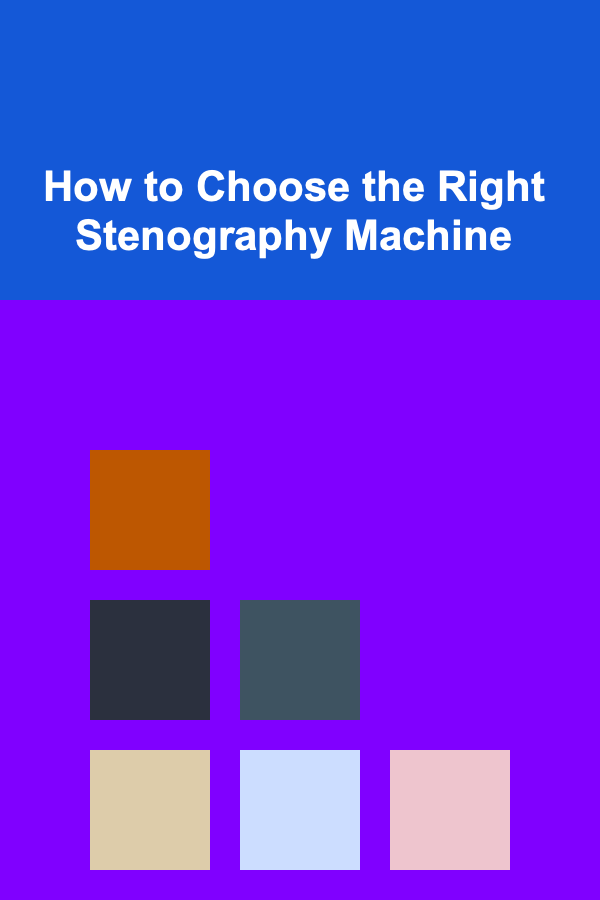
How to Choose the Right Stenography Machine
ebook include PDF & Audio bundle (Micro Guide)
$12.99$9.99
Limited Time Offer! Order within the next:

Stenography, or shorthand, is the art of transcribing speech into written form at high speed. This skill is particularly important for court reporters, transcriptionists, and professionals in various fields who need to capture spoken language quickly and accurately. A stenography machine is a key tool for stenographers, helping them convert live speech into written text with incredible speed.
However, choosing the right stenography machine is not always straightforward. With numerous options available on the market, it's essential to consider various factors such as usability, features, reliability, and cost. In this article, we will explore the key aspects you should keep in mind when selecting a stenography machine to ensure it meets your needs and enhances your performance.
What is a Stenography Machine?
A stenography machine is a specialized keyboard used for shorthand writing. It has fewer keys than a standard typewriter or computer keyboard, and each key represents a combination of sounds, syllables, or words. This allows stenographers to write at speeds that can match the rate of speech, making it ideal for real-time transcription.
Stenographers use a machine to press multiple keys simultaneously, producing different syllables, words, or phrases. This system is known as "chording," and it is the key to achieving high-speed transcription. The output of a stenography machine is typically translated into text using computer software that converts the shorthand into readable English or other languages.
Types of Stenography Machines
Before diving into the features of a stenography machine, it's important to understand the different types of machines available:
-
Traditional Stenotype Machines
- These are the most commonly used machines in legal and court reporting. They have a small keyboard with multiple keys for chording, and they require a stenographer to learn specific key combinations for transcription. The output is often stored in a file format that can be later translated into readable text.
-
Stenograph Machines
- Stenograph machines are typically used for real-time transcription in courtrooms and depositions. They come with specialized software for easy translation into text and offer additional features, such as wireless capabilities for reporting in remote locations.
-
Computer-Assisted Transcription (CAT) Machines
- CAT machines are modern stenography machines that incorporate both hardware and software to make transcription easier and more efficient. These machines usually come with touch screens, wireless connectivity, and advanced editing features, allowing the stenographer to correct mistakes easily.
Key Considerations for Choosing a Stenography Machine
When purchasing a stenography machine, several factors should be taken into account to ensure you select the one that best suits your needs. Below, we break down the most important considerations.
Speed and Performance
The primary reason for using a stenography machine is to transcribe speech as quickly as possible. Speed is one of the most critical aspects to consider when choosing a machine.
- Stenotype Speed: Traditional stenography machines allow for speeds of up to 200 words per minute (WPM), but high-end models can support speeds of 300 WPM or more. If you're working in a high-speed environment, such as a courtroom or a live broadcast, choose a machine that can accommodate higher speeds.
- Latency: The machine should have low latency between pressing the keys and seeing the result. If there is any delay, it could cause errors and disrupt the flow of transcription.
- Accuracy: Speed is important, but accuracy is paramount. Ensure the machine you choose is capable of accurately capturing speech without errors. Machines with more advanced translation software tend to offer better accuracy by reducing misinterpretations of shorthand.
Ergonomics and Comfort
Stenographers often work for long hours, so the ergonomics of the machine are essential. A poorly designed stenography machine can cause discomfort or even repetitive strain injuries. Look for the following ergonomic features:
- Key Layout: The layout of the keys should feel natural and intuitive. The keys should be spaced to allow your fingers to move comfortably without cramping.
- Keyboard Size: Some stenographers prefer a smaller, compact machine, while others opt for larger keyboards. Choose one that fits your hand size and typing style.
- Weight: The machine should be lightweight and easy to transport, especially if you plan to use it in multiple locations, such as courts or conferences.
- Adjustable Key Sensitivity: A machine with adjustable key sensitivity ensures you don't press the wrong key unintentionally, which is crucial for speed and accuracy.
Software Compatibility and Features
In modern stenography, the machine's software plays a significant role in ensuring smooth and effective transcription. Most stenography machines today come with their own translation software or are compatible with third-party programs.
- Translation Software: Look for a stenography machine that includes advanced translation software that can convert shorthand into readable text. Some popular stenography software includes Case CATalyst, Stenograph, and Eclipse. The software should be user-friendly, and it should be able to handle common legal terms or industry-specific jargon.
- Real-Time Transcription: If you're working in a courtroom or other real-time environments, look for a machine that offers real-time transcription capabilities. This allows you to transcribe and display text instantly as you type.
- Backup and Recovery: Ensure the machine has a reliable backup and recovery system in place, especially if you are working with important legal or medical documents. A crash during a live transcription could be disastrous.
Connectivity and Integration
Connectivity is becoming increasingly important as more stenographers are working in remote locations or collaborating with teams. Look for the following connectivity options:
- Wireless Capability: Many modern stenography machines offer Bluetooth or Wi-Fi connectivity, enabling stenographers to transmit data wirelessly to computers, tablets, or cloud storage. This is particularly useful in environments where mobility is essential.
- File Export and Compatibility: The machine should be compatible with industry-standard file formats, such as .txt or .pdf, and it should allow you to export your transcriptions easily. It should also integrate seamlessly with other software tools you may use for editing, archiving, or sharing.
- Cloud Integration: Some stenography machines can automatically upload files to cloud storage platforms, ensuring that your data is securely backed up and easily accessible across devices.
Customization and User Preferences
Every stenographer has different preferences when it comes to how they work. Look for a machine that offers customization options, such as:
- Custom Shortcuts: Some stenography machines allow you to program custom shortcuts for frequently used phrases, terms, or abbreviations. This can help speed up the transcription process and reduce the strain on your hands.
- Key Customization: Certain models allow you to adjust the function of specific keys, making it easier for you to personalize the machine according to your workflow.
- User Profiles: If multiple people will be using the machine, look for one that allows for the creation of user profiles. This makes it easier to switch between settings based on individual preferences.
Durability and Reliability
A stenography machine is a significant investment, so durability is an essential factor. The machine should be built to withstand frequent use, transport, and possibly even rough conditions. When choosing a machine, consider the following:
- Build Quality: Look for machines made from high-quality materials that are built to last. While cheaper models may be more affordable, they often wear out faster.
- Warranty and Support: Make sure the manufacturer offers a warranty and customer support. Having access to reliable technical support can save you time and money in case you encounter issues with the machine.
- Battery Life: If you plan to use your stenography machine for extended periods, ensure that the battery life is long enough to support your needs. Look for a machine with a battery that lasts at least 6-8 hours on a single charge.
Price and Budget
Stenography machines come in a wide range of prices, with basic models starting at a few hundred dollars and high-end machines costing several thousand. When deciding on a budget, keep in mind the following:
- Affordability vs. Features: Higher-priced machines typically offer more features, such as better speed, more customization options, and more advanced software. However, there are also many mid-range machines that offer excellent value for money without compromising on quality.
- Long-Term Investment: Although high-end stenography machines may have a higher upfront cost, they can be a good investment in the long run. A machine with more advanced features and higher reliability can improve your workflow and increase productivity, ultimately saving you time and money.
Reviews and Recommendations
Before making your final decision, take the time to read reviews and recommendations from other stenographers. Online forums, reviews from industry professionals, and feedback from peers can provide valuable insights into the pros and cons of specific models. You can also attend trade shows or conferences where stenographers gather to test out machines and get hands-on experience with different models.
Conclusion
Choosing the right stenography machine is a critical decision for any stenographer, as it will directly impact your productivity, comfort, and transcription accuracy. By considering factors such as speed, ergonomics, software compatibility, connectivity, and budget, you can select a machine that will help you succeed in your profession.
Keep in mind that while price is an important factor, it should not be the only consideration. It's essential to invest in a machine that offers the features and durability you need to perform your best, even if that means spending a bit more upfront. In the end, the right stenography machine can make a world of difference in your workflow, efficiency, and overall satisfaction with your work.
Reading More From Our Other Websites
- [Home Holiday Decoration 101] How to DIY Holiday Garlands and Banners for a Festive Touch
- [Home Budget Decorating 101] How to Decorate Your Home Like a Designer on a Budget
- [Home Lighting 101] How to Mix Ambient, Task, and Accent Lighting in Your Home
- [Organization Tip 101] How to Organize Craft Supplies in the Family Room
- [Organization Tip 101] The Benefits of Using Kitchen Cabinet Refacing Kits for a Budget-Friendly Upgrade
- [Home Renovating 101] How to Achieve the Best Bathroom Makeovers on a Budget
- [Home Soundproofing 101] How to Soundproof Your Home to Create a Meditation Space
- [Personal Care Tips 101] How to Use Shampoo to Prevent Hair Thinning
- [Star Gazing Tip 101] Star Trails Explained: Planning, Shooting, and Post-Processing Tips
- [Stamp Making Tip 101] Eco-Friendly Rubber Stamp Making: Sustainable Materials and Practices

How to Create a Functional and Organized Craft Corner
Read More
How to Start Saving for Retirement in Your 20s
Read More
How to Use Rugs to Define Spaces in Staging
Read More
How to Understand the Basics of Blockchain
Read More
How to Create a Memorable Brand Identity
Read More
How to Break Free from Negative Thought Patterns
Read MoreOther Products

How to Create a Functional and Organized Craft Corner
Read More
How to Start Saving for Retirement in Your 20s
Read More
How to Use Rugs to Define Spaces in Staging
Read More
How to Understand the Basics of Blockchain
Read More
How to Create a Memorable Brand Identity
Read More